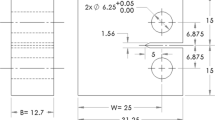Abstract
Material defects growing during fatigue or damage process are described in terms of fractals. The assumed, uniform energy distribution over fractal defects corresponds to generalized energy density, treated as material characteristics. It has been shown that the way of evolution as well as the main features of an irreversible process are determined by characteristic (for a given material) fractal measures. The macroscopic range of length scales has been introduced via additional energy dependence upon macroscopic volume limiting defects evolution. Under certain constrains imposed upon defects growth, the effect similar to phase transition can be observed. The transition point coincides with the singularity of characteristic measures. In turn, the singularity comes from macroscopic limitations of defects growth. Theoretical results are compared with numerical simulations of the simplified stochastic fibre break process in composites. The simplified model has been generated in a way allowing to exclude heat outflow from the simulated system. This makes possible to examine defects growth over full range of scales beginning with the microscopic level. The calculated singularity appears at percolation point when observed correlated defects approach macroscopic size in accordance with the proposed theoretical model.
Key words: Fatigue process, fractal defects theory, numerical simulations.
Similar content being viewed by others
References
Bažant, Z. P. (1997a). Scaling of Quasibrittle Fracture: Asymptotic Analysis, International Journal of Fracture, 83, No. 1, 19–40.
Bažant, Z. P. (1997b). Scaling of Quasibrittle Fracture: Hypothesis of Invasive and Lacunar Fractality, Their Critique and Weibull Connection, International Journal of Fracture, 83, No. 1, 41–65.
Bažant, Z. and Planas, J. (1998). Fracture and size effect, CRC Press, Boca Raton.
Carpinteri, A. and Chiaia, B. (1996). Power Scaling Laws and Dimensional Transitions in Solid Mechanics, Chaos, Solitons and Fractals, 7, 1343–1364.
Datta, D., Munshi, P. and Kishore, N. N. (1996). Automated Utrasonic NDE of Composite Specimens by Cluster and Fractal Analysis, Nondestr. Test. Eval. 13, 15–30.
Falconer, K. (1990). Fractal geometry, Chichester, New York, John Wiley & Sons.
Gandmaher, F. R. (1988). Matrix theory, Nauka, Moscow (in Russian).
Goldsztein, R. W. and Mosolov, A. B. (1991). Cracks with fractal surfaces, WAN SSSR, 319 Nr 4 (in Russian).
Goldsztein, R. W. and Mosolov, A. B. (1992). Fractal cracks, PMM. 56 (in Russian).
Kasprzak, W., Lysik, B. and Rybaczuk, M. (1990). Dimensional Analysis in the Identification of Mathematical Models, World Scientific, Singapore New Jersey.
Kohomoto, M. (1988). Entropy Function for Multifractals, Phys. Rev. A37, 1345–1350.
Nottale, L. (1996). Scale, Relativity and Fractal Space- Time: Applications to Quantum Physics, Cosmology and Chaotic Systems, Chaos, Solitons & Fractals, 7, 877–938.
Rybaczuk, M. (1992). The Fatigue Evolution of Fractal Defects in Metals (Edited by K. T. Rie), proceedings of Third International Conference on Low Cycle Fatigue and Elasto-Plastic Behavior of Materials, Elsevier London and New York.
Rybaczuk, M. (1997). The Fractal Model of Defects Growth in Solids (Edited by R. C. Tennyson, A. E. Kiv), Computer Modelling of Electronic and Atomic Processes in Solids, Kluwer Academic Publishers, 309–320.
Stoppel, P. (1999). Simulations of Fibres Breaking in the Stochastic Model of Composite, unpublished thesis (in Polish).
Stoppel, P. and Rybaczuk, M. (1997). Simulations of Random Fractal Fiber Breaking in Composites (Edited by Karihaloo B. L., Mai Y.-W., Ripley M. I. and Richie R. O.), Advances in Fracture Research (ICF9), Amsterdam, Oxford, Pergamon, 849–856.
Volterra, V. and Hostinsky, B. (1938). Opérations Infinitésimales linéares, Herman, Paris.
Author information
Authors and Affiliations
Rights and permissions
About this article
Cite this article
Rybaczuk, M., Stoppel, P. The fractal growth of fatigue defects in materials. International Journal of Fracture 103, 71–94 (2000). https://doi.org/10.1023/A:1007635717332
Issue Date:
DOI: https://doi.org/10.1023/A:1007635717332




